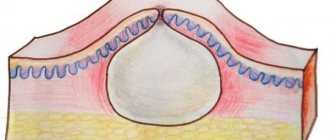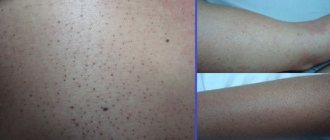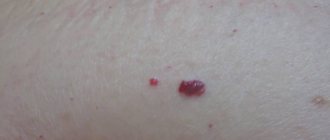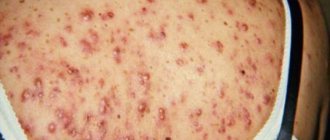Searching for a diagnosis on the Internet is an interesting, but dangerous activity. After all, having made a diagnosis for yourself, you can prescribe treatment yourself. What if it is incorrect? Don’t take risks, only a doctor can make a correct diagnosis after examining the tests. Still, let's try to figure out what kind of mess it is - bumps on the forehead above the eyebrows and what kind of healing awaits in this or that case.
Only a doctor can make a diagnosis
Causes
People often suffer from swelling in different parts of the body, which has many causes. Swelling in the eyebrow area is no different. The tumor can be caused by an external factor or an internal disease. The main reasons that can cause swelling of the eyebrows are considered to be the following:
NOTE. The information provided is not a substitute for an actual physical medical examination. Please visit your healthcare provider to determine the exact cause before starting medication.
Swelling due to illness and other factors
The first possible cause of eyebrow swelling is edema - this is swelling that occurs due to the retention of lymphatic fluid in the tissues and cavities of the body.
In this case, a swollen eyebrow is the result of fluid leaking from the capillaries that are located around the eye. Symptoms appear gradually. This swelling may be caused by a hidden infection. Other possible causes include: prolonged sitting or standing, surgery, high altitude, sunburn, pregnancy, and complete lack of physical activity.
Serious medical conditions that can cause swelling are arthritis, pulmonary insufficiency, thyroid dysfunction, diabetes and liver disease. Associated symptoms will include:
- Swelling of the skin
- Itching
- Weight gain
- Increased heart rate
- Skin may appear glossy and tight
Treatment in this case most often involves eliminating the infection, if any. Otherwise, therapy will include:
- Diuretics are medications that help increase urination and remove excess fluid through the kidneys.
- Ranibizumab is a medicine approved in more than 85 countries that helps prevent and treat macular edema in diabetes.
- Control of blood vessel growth or therapeutic angiogenesis.
Treatment of edema with medications
After determining the cause of swelling of the brow ridges, you need to pay attention to eliminating them. Until the provoking factor disappears, the problem will persist.
If a doctor prescribes treatment using pharmaceuticals, you must strictly follow his recommendations without arbitrarily interrupting the recommended course of therapy. It must be remembered that next to the eyebrows are the eyes, which are extremely sensitive to any kind of infection.
Antihistamines
To make swelling go away faster, especially when it was caused by the use of aggressive cosmetics, it is necessary to use antihistamines.
They differ in their types:
- first generation (Diphenhydramine, Tavegil, Diazolin);
- second generation (Zyrtec, Clarotadine, Claritin);
- third generation (Telfast, Gismanal, Trexil);
- natural (vitamin B12, ascorbic acid, zinc, fish oil, pantothenic acid, nicotinic acid).
Before actively using a new cosmetic product, you need to test it on a small area of the body to monitor possible reactions of the body.
Dexamethasone
Dexamethasone is a synthetic glucocorticosteroid prescribed for allergies, swelling of the eyebrows caused by a blow.
Dexamethasone has the following effects on the body:
- relieving inflammation;
- elimination of allergies;
- immunosuppressive effect.
In medical practice, it is possible to instill the drug directly into the eyes (in the presence of serious pathologies); in other cases, it is used topically, making lotions.
Prescription of the drug is possible only by a specialist; self-medication with its use is not allowed.
Hydrocortisone ointment
Hydrocortisone ointment can relieve swelling of the skin; it has a pronounced anti-inflammatory and antihistamine effect.
The ointment is used as follows:
- apply a thin layer to the damaged surface;
- after 10 minutes, remove the residue using a cotton pad;
- repeat up to 4 times a day.
The medicine has the ability to prevent the formation of scars after a severe cut or bruise.
Not everyone can use hydrocortisone ointment; there is a list of contraindications for which it is prohibited for use, these include pregnancy and severe injuries to the eye area.
Preparations for cutting eyebrows
To relieve swelling, you can use synthetic adhesives that contain cinacrylates. They have high strength, harden quickly, and do not have a harmful effect on the human body.
The use of cinacrylates is indicated for small wounds (up to 1 by 3 cm). This glue will reliably close the wound and fix the skin, which will reduce tissue swelling.
In modern medicine, the method of ultrasonic welding of damaged tissues is used.
Medicines to treat diseases
To relieve swelling in the eyebrows, you need to consult a doctor, no matter how insignificant the problem that caused it may seem.
If you try to solve the problem on your own, there is a high probability that it will only get worse. Whereas timely intake of certain medications can relieve the acute course of the disease after one or two days.
Relief of swelling after epilation (with wax, tweezers or thread)
If the technology of this procedure is not performed correctly or the wrong tools are used, there is a possibility of damage to the hair follicles, and this can cause swelling and inflammation of the eyebrows.
The following tips will help relieve swelling after waxing:
- Cleanse your face with a soothing and antiseptic lotion
- To reduce redness, rub your face with an ice cube
- Use moisturizers such as baby cream
- Avoid wearing makeup.
How to make a preliminary diagnosis yourself
The photo shows a blockage of the sebaceous duct
If a lump appears under the eyebrow, then it can be either a banal pimple near the eyebrow, which does not require surgical intervention, or a very serious tumor that requires prompt professional medical intervention.
Removal using modern methods, quickly and safely
| Types of seals | Primary diagnosis | Treatment |
| Lipoma | A benign formation that occurs due to blockage of the sebaceous ducts of the skin. Most often observed with oily facial skin and a passion for sweets and fried foods. There is no pain when pressed, the skin is not reddened. | Surgery |
| Intradermal cyst (atheroma) | A dense formation under the skin. It can be caused by both hormonal imbalance and hereditary factors. May become inflamed periodically. | Operation |
| Furuncle, abscess | There is redness of the skin, acute pain and fever. | Antibiotics or excision |
| Malignant tumor | It may be completely painless, but a change in skin color is usually observed. | Only the doctor will decide |
| Consequences of injury after impact | Proper blood circulation is disrupted, so injured tissues cannot recover normally. | Local treatment |
| Sinusitis | The tumor is observed in the area of the maxillary sinuses above the eyebrow, closer to the bridge of the nose. Acute pain with sudden movement of the head. | X-ray, doctor prescribes treatment |
Important. Be sure to get an x-ray and be examined by a specialist. Self-diagnosis and treatment delay the correct identification of the disease and may miss the opportunity for quick and effective treatment in the early stages.
Eyebrows swollen for no reason
Sometimes the eye can become swollen for no apparent reason. If medical examination does not reveal an infection, then it can be assumed that the cause is an autoimmune disorder.
Autoimmune diseases occur when the body produces antibodies that begin to fight your own body cells. This can lead to swelling and inflammation of the skin around the affected areas. In most cases, the condition does not go away on its own, and hormonal therapy may be required throughout life. Signs and symptoms of an autoimmune disorder vary from one person to another depending on how strong the immune system is.
The actual cause of an autoimmune disorder is unknown, but the following factors may trigger an attack by the immune system:
- Virus or bacteria attack
- Medicines
- Chemical irritants such as soap or body lotion
- Environmental irritant during climate change
Autoimmune disorders are chronic conditions for which there is no cure yet, but it is possible to relieve symptoms and prevent spread to other parts of the body with the following tips.
- Eat a balanced diet
- Make time for physical activity regularly
- Take Vitamin A
- Limit your time in the sun
- You need to reduce your overall stress level.
Folk remedies
You can get rid of acne that appears above the eyebrows using traditional methods of treatment. But you need to choose only proven options that are actually effective.
- Wipe the areas of inflammation above the eyebrows with natural, freshly squeezed aloe juice. This can be done up to 3 times a day.
- Make compresses with calendula infusion. Brew a spoonful of herbs with a glass of boiling water, cover with a lid, leave for 30 minutes, strain. Soak a cotton pad in the liquid and apply it to the acne for 20 minutes. You can also wash your face with calendula infusion in the morning and evening.
- Onion applications that help with already mature acne. An onion cut in half is fried in a dry frying pan, after which it is applied while still warm to the inflamed area, and the compress is fixed on top with a plaster.
- Lubricate the areas of inflammation with freshly squeezed lemon juice several times a day.
- Soda masks. Dilute the same amount of soda in a tablespoon of water to obtain a paste, apply the latter to the inflamed areas above the eyebrows.
- Lubricate pimples with egg white, wait until completely dry, and then rinse with water.
You can use such methods for treating acne above the eyebrows only after consulting a doctor. They can also be alternated with the use of ointments and creams prescribed by a dermatologist.
Swelling on the forehead above the eyebrow
The presence of swelling on the forehead may be the most noticeable sign of an infection or a simple allergic reaction to an irritant, also called contact dermatitis. Is this swelling serious or not? For many people, any unexplained swelling can be a cause for concern. For people with a strong immune system or those who exercise regularly and eat a balanced diet, this problem usually goes away within a day or two.
When the swelling is not caused by another condition, then a simple warm compress and the use of anti-inflammatory ointments or gel should help return the facial skin to normal. Otherwise, if the swelling does not go away after a week, you need to undergo a medical examination to determine the cause. Only after a complete examination will the doctor be able to prescribe adequate treatment.
Among all the reasons that cause swelling of the forehead, the most common are the following:
- Contact dermatitis is when the body reacts after physical contact with an irritant. It can lead to an itchy and painful rash on the skin.
- An autoimmune disorder occurs when the body begins to react abnormally to normal and healthy body cells.
- Allergic reaction to food or soap. For many people, various chemical components present in soap can irritate the skin, causing it to swell. Mineral composition in foods such as vitamins and proteins can also cause swelling in the same people.
- External trauma , physical damage to the face with a hard object, can cause swelling of the forehead.
When to go to the doctor
A huge pimple above the eyebrow is a clear reason to visit a doctor. Especially if you want to get rid of the disease quickly and forever. Indeed, at home using traditional medicine methods this is rarely possible.
First of all, you need to make an appointment with a dermatologist, and then, if necessary, visit an infectious disease specialist or gastroenterologist. If the rashes on the face are allergic in nature, then an allergist will help get rid of them.
After conducting a series of tests and finding out the causes of the rash, the doctor will prescribe the correct treatment, which will lead to a quick recovery and help prevent new manifestations of acne in the future.
Swollen eyebrow bone and headache
A swollen eyebrow bone is likely to cause severe pain. In most cases, this swelling indicates a more serious condition. This is often caused by damage to the orbital bone, which serves as the socket for the eyeball.
A common cause of orbital bone injury is external trauma and contusion. This can happen as a result of an accident or a blow to the eyebrow with a hard object. Other causes may include improper waxing techniques where severe tension occurs on the skin.
The most common visible symptoms of orbital bone swelling include:
- Strong headache
- Painful sensations in the eye socket
- Swollen eyebrow
- There may also be problems with vision
- Redness of the eyes
- Numbness of cheeks, nose and teeth
- Episodes of nosebleeds may occur.
When treating a damaged bone, you need to be very careful with the type of anti-inflammatory ointments you apply. You should also make sure that the product does not come into contact with the mucous membrane of the eyes, as this can lead to irritation. You can apply a cold or warm compress to your eyebrow to soothe the skin and prevent further swelling.
If symptoms persist or pain and swelling do not go away after a week, contact your doctor.
Prevention
Swelling of the brow ridges is not always a symptom of a dangerous disease; most often, the cause lies in a banal disorder of the hyena or the development of an allergic reaction. In any case, if the symptoms cause severe concern, you should immediately seek help from a doctor.
To ensure that swelling goes away quickly and does not occur again, you need to:
- in case of severe pain, take analgesics;
- after the tattoo procedure, carefully carry out all care measures that were recommended by the cosmetologist;
- full compliance with hygiene standards at normal times and after carrying out certain cosmetic procedures;
- strict adherence to techniques for correcting unwanted hair;
- careful selection of the master and the salon where any facial skin procedures are planned.
We recommend reading: Beard for a round face










